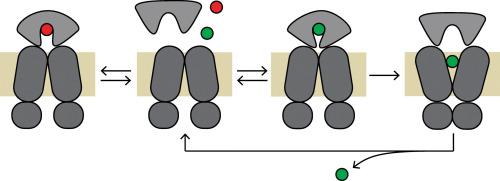Journal of Molecular Biology ( IF 4.7 ) Pub Date : 2020-08-12 , DOI: 10.1016/j.jmb.2020.08.008 Marijn de Boer 1 , Thorben Cordes 2 , Bert Poolman 3

|
Prokaryotic ATP-binding cassette (ABC) importers require a substrate-binding protein (SBP) for the capture and delivery of the cognate substrate to the transmembrane domain (TMD) of the transporter. Various biochemical compounds have been identified that bind to the SBP but are not transported. The mechanistic basis for the “non-cognate” substrates not being transported differs. Some non-cognate substrates fail to trigger the appropriate conformational change in the SBP, resulting in loss of affinity for the TMD or the inability to allosterically activate transport. In another mechanism, the SBP cannot release the bound non-cognate substrate. Here, we used rate equations to derive the steady-state transport rate of cognate substrates of an ABC importer and investigated how non-cognate substrates influence this rate. We found that under limiting non-cognate substrate concentrations, the transport rate remains unaltered for each of the mechanisms. In contrast, at saturating substrate and SBP concentrations, the effect of the non-cognate substrate depends heavily on the respective mechanism. For instance, the transport rate becomes zero when the non-cognate substrate cannot be released by the SBP. Yet it remains unaffected when substrate release is possible but the SBP cannot dock onto the TMDs. Our work shows how the different mechanisms of substrate inhibition impact the transport kinetics, which is relevant for understanding and manipulating solute fluxes and hence the propagation of cells in nutritionally complex milieus.
中文翻译:

ABC进口商中底物抑制运输的动力学模型。
原核ATP结合盒(ABC)进口商需要底物结合蛋白(SBP)才能将同源底物捕获并转运至转运蛋白的跨膜结构域(TMD)。已经鉴定了与SBP结合但未被转运的各种生化化合物。未运输“非同源”基材的机制基础有所不同。一些非同源底物无法触发SBP中适当的构象变化,从而导致对TMD的亲和力丧失或无法变构激活转运。在另一种机制中,SBP无法释放结合的非同源底物。在这里,我们使用速率方程来得出ABC进口商的同源底物的稳态传输速率,并研究了非同源底物如何影响该速率。我们发现,在限制非同源底物浓度的情况下,每种机制的转运速率均保持不变。相反,在饱和底物和SBP浓度下,非同源底物的作用在很大程度上取决于相应的机理。例如,当非同源底物不能被SBP释放时,传输速率变为零。但是,当可能释放底物但SBP无法停靠在TMD上时,它仍然不受影响。我们的工作表明底物抑制的不同机制如何影响运输动力学,这与理解和操纵溶质通量以及营养复杂的环境中细胞的繁殖有关。在饱和底物和SBP浓度下,非同源底物的效果在很大程度上取决于相应的机理。例如,当非同源底物不能被SBP释放时,传输速率变为零。但是,当可能释放底物但SBP无法停靠在TMD上时,它仍然不受影响。我们的工作表明底物抑制的不同机制如何影响运输动力学,这与理解和操纵溶质通量以及营养复杂的环境中细胞的繁殖有关。在饱和底物和SBP浓度下,非同源底物的效果在很大程度上取决于相应的机理。例如,当非同源底物不能被SBP释放时,传输速率变为零。但是,当可能释放底物但SBP无法停靠在TMD上时,它仍然不受影响。我们的工作表明底物抑制的不同机制如何影响运输动力学,这与理解和操纵溶质通量以及营养复杂的环境中细胞的繁殖有关。但是,当可能释放底物但SBP无法停靠在TMD上时,它仍然不受影响。我们的工作表明底物抑制的不同机制如何影响运输动力学,这与理解和操纵溶质通量以及营养复杂的环境中细胞的繁殖有关。但是,当可能释放底物但SBP无法停靠在TMD上时,它仍然不受影响。我们的工作表明底物抑制的不同机制如何影响运输动力学,这与理解和操纵溶质通量以及营养复杂的环境中细胞的繁殖有关。











































 京公网安备 11010802027423号
京公网安备 11010802027423号